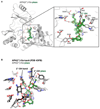Plazomicin Retains Antibiotic Activity against Most Aminoglycoside Modifying Enzymes
- PMID: 29634241
- PMCID: PMC6167752
- DOI: 10.1021/acsinfecdis.8b00001
Plazomicin Retains Antibiotic Activity against Most Aminoglycoside Modifying Enzymes
Abstract
Plazomicin is a next-generation, semisynthetic aminoglycoside antibiotic currently under development for the treatment of infections due to multidrug-resistant Enterobacteriaceae. The compound was designed by chemical modification of the natural product sisomicin to provide protection from common aminoglycoside modifying enzymes that chemically alter these drugs via N-acetylation, O-adenylylation, or O-phosphorylation. In this study, plazomicin was profiled against a panel of isogenic strains of Escherichia coli individually expressing twenty-one aminoglycoside resistance enzymes. Plazomicin retained antibacterial activity against 15 of the 17 modifying enzyme-expressing strains tested. Expression of only two of the modifying enzymes, aac(2')-Ia and aph(2″)-IVa, decreased plazomicin potency. On the other hand, expression of 16S rRNA ribosomal methyltransferases results in a complete lack of plazomicin potency. In vitro enzymatic assessment confirmed that AAC(2')-Ia and APH(2'')-IVa (aminoglycoside acetyltransferase, AAC; aminoglycoside phosphotransferase, APH) were able to utilize plazomicin as a substrate. AAC(2')-Ia and APH(2'')-IVa are limited in their distribution to Providencia stuartii and Enterococci, respectively. These data demonstrate that plazomicin is not modified by a broad spectrum of common aminoglycoside modifying enzymes including those commonly found in Enterobacteriaceae. However, plazomicin is inactive in the presence of 16S rRNA ribosomal methyltransferases, which should be monitored in future surveillance programs.
Keywords: Enterobacteriaceae; aminoglycoside-modifying enzymes; antibiotic resistance; plazomicin.
Figures



References
-
- Brown ED, and Wright GD (2016) Antibacterial drug discovery in the resistance era. Nature 529 (7586), 336–343. - PubMed
-
- Pawlowski AC, Johnson JW, and Wright GD (2016) Evolving medicinal chemistry strategies in antibiotic discovery. Curr. Opin. Biotechnol 42, 108–117. - PubMed
-
- Armstrong ES, and Miller GH (2010) Combating evolution with intelligent design: the neoglycoside ACHN-490. Curr. Opin. Microbiol 13 (5), 565–573. - PubMed
-
- Bacot-Davis VR, Bassenden AV, and Berghuis AM (2016) Drug-target networks in aminoglycoside resistance: hierarchy of priority in structural drug design. MedChemComm 7 (1), 103–113.
Publication types
MeSH terms
Substances
Grants and funding
LinkOut - more resources
Full Text Sources
Other Literature Sources
Medical

